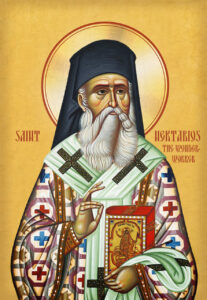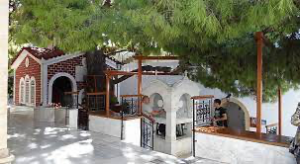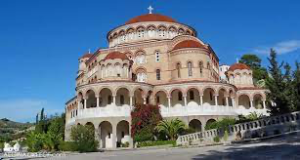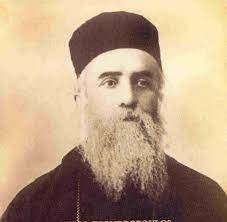The Life of Saint Nektarios (before and after he died)
After Bishop Nektarios died, his sweater was inadvertently laid on the bed of the man in the infirmary next to him. The man who had been crippled for years immediately stood up and began to walk, and a sweet fragrance filled the room. This was the beginning of his miracles. The infirmary has since been turned into a chapel.
 I had heard of Saint Nektarios for years, since he is commemorated in the Proskomedia service (“preparation” of the Holy Gifts, the bread and wine) before Divine Liturgy. Someone had given me a small icon of him which I put on on the wall at Saint Nicholas Church, and I had occasionally used oil from the lamps at Saint Nektarios for anointing, but I didn’t really know much about him. Then in the year 2000 Tony and Chrys Wood, two parishioners, visited his shrine and brought me a book about him which moved me deeply.
I had heard of Saint Nektarios for years, since he is commemorated in the Proskomedia service (“preparation” of the Holy Gifts, the bread and wine) before Divine Liturgy. Someone had given me a small icon of him which I put on on the wall at Saint Nicholas Church, and I had occasionally used oil from the lamps at Saint Nektarios for anointing, but I didn’t really know much about him. Then in the year 2000 Tony and Chrys Wood, two parishioners, visited his shrine and brought me a book about him which moved me deeply.
Nektarios had a difficult life. Originally from Greece, born in 1846, he became a bishop while serving in Alexandria, Egypt, where other clergy took a disliking to him for some reason and stirred up trouble for him even after he returned to Greece. A humble man, he lived a life of great wisdom, patience and forbearance and finally founded a monastery for women on Aegina (pronounced EGGina), an island just off Athens. However, his life seemed to be nothing very extraordinary until he died in Athens on November 9, 1920, and the miracles began, a multitude of them. He seems to have a special concern for cancer patients. There are many stories of Saint Nektarios appearing to people, especially in dreams. He has become probably the most popular saint in Greece, and certainly the most revered Orthodox saint of the twentieth century. I had read many saints’ stories, but for some reason as I read of Nektarios’ first miracle, I got the holy chills. I wanted to visit him.
Off to see Saint Nektarios
 So I did. I took the train from Thessaloniki down to Athens – a beautiful trip past Mount Olympus, through the plains of Thessaly, then up and over the mountains into Athens. (Why do people fly and miss all this?) After spending a day in bed recovering from Mount Athos, Tuesday September 24 was my day to go to Aegina. It was an amazing day.
So I did. I took the train from Thessaloniki down to Athens – a beautiful trip past Mount Olympus, through the plains of Thessaly, then up and over the mountains into Athens. (Why do people fly and miss all this?) After spending a day in bed recovering from Mount Athos, Tuesday September 24 was my day to go to Aegina. It was an amazing day.
I was to take the ferry to Crete that night, so I left my backpack at the hotel in Athens, took the Metro (the Athens subway, though some of it is above ground) to Piraeus the port of Athens, and planned to catch the 9 o’clock ferry to Aegina, about a one hour voyage. However, I had some business to tend to and missed the 9 o’clock boat. “No problem”, as the Greeks say in all circumstances. I had been assured that boats run every hour. But not that day. No 10 o’clock boat. The next one was at 11.
I wondered if I should give up on the visit. I didn’t know the island. For reasons I can’t explain, I hadn’t even looked up where the shrine of Saint Nektarios was or how to get there. Would there be time to get to Saint Nektarios, then back to the hotel and then return to Piraeus again to catch the evening boat? But I so much wanted to go, and I heard myself saying, “Agios Nektarios, Saint Nektarios, I’m coming to visit you. You’ve got to work this out and get me back in time.” Well…! My request was definitely answered.
A series of “coincidences” (?)
I should tell you that since I was not on official business, as usual I was not dressed as a priest, so little of what followed was the result of “clerical privilege”.

Sitting at the front of the 11 o’clock ferryboat was a young priest. Perhaps, I thought, he was going to visit Saint Nektarios. Maybe I could follow him, or at least he could tell me how to get there. So I went up and asked, “Do you speak English?” “Not very well,” he answered. When I began to mutter in my primitive Greek, he said, “I speak Greek even less.” It turned out he was Russian, a priest monk, Father Kallistratos, from Trinity St. Sergius Monastery outside Moscow, an extremely pleasant and very pious young man of 28 years, who in fact spoke good English. He also had just been to the Holy Mountain, and had climbed the 6500 feet to the top of Mount Athos so he could celebrate Divine Liturgy at the little chapel up there at dawn. He was indeed going to visit Saint Nektarios, for the second time. He was to be met by a friend, a retired Greek man whom he had met on his previous trip, who would take him out to the shrine. Father Kallistratos said, “Please come along.”
So I got a free ride to the shrine and monastery of Saint Nektarios and, thanks to Father Kallistratos, a tour and explanation of what it was all about from the inside – things I would never have found by myself. The resting place of Saint Nektarios (except that he doesn’t seem to be resting much!) is a beautiful, light-filled, airy place up in the hills, with a great sense of peace about it. When I came before Saint Nektarios’ tomb I was just overwhelmed, and I (Father “Cool”, always in charge of my emotions, at least in public) started to cry, not for sorrow, not at all. There was a woman clinging to the tomb and crying the whole time I was there – in her case, I’m sure, out of sorrow. Pray for her. Even today, fifteen years later, pray for her.
I litcandles and prayed for all the people whose names my parishioners had given me and for others too. It was then that Father Kallistratos asked, “Do you want your names to be put on the Proskimedia list? Just give the list to that woman there.” Yes, I certainly did! So we were prayed for at Divine Liturgy before Saint Nektarios – again, something I never could have arranged by myself. And then I met some of the nuns and saw the inside of the house where Nektarios lived, and the icon which inspired his popular Orthodox hymn “Rejoice, O Unwedded Bride”. Father Kallistratos stood there and sang the hymn to the Theotokos in Russian, and I stood there frustrated because I couldn’t remember it in English. I came home and corrected that.
Here is the hymn sung in both Greek and English. Eikona is composed of three sisters, daughters of an American Greek Orthodox priest.
Father Kallistratos was also much devoted to Saint Nicholas. He said about every second church in Russia is dedicated to Nicholas, and he was pleased to know that ours also was Saint Nicholas Church. He was traveling next to Bari in southern Italy where the body of Saint  Nicholas lies. A Russian priest there has permission to celebrate Divine Liturgy at the tomb of Saint Nicholas. Father Kallistratos was going to do the same, and he said he would pray for us, so we were prayed for at Divine Liturgy at the tomb of our patron Saint Nicholas! which, by the way, is a very holy place. I’ll tell you later about my visit there in 2005.
Nicholas lies. A Russian priest there has permission to celebrate Divine Liturgy at the tomb of Saint Nicholas. Father Kallistratos was going to do the same, and he said he would pray for us, so we were prayed for at Divine Liturgy at the tomb of our patron Saint Nicholas! which, by the way, is a very holy place. I’ll tell you later about my visit there in 2005.
Father Kallistratos was staying, so I moved on. I looked through the gift shop and bought an icon, and went down the hill and checked out  the big Saint Nektarios church which was not yet completed. Then I thought maybe I should start planning how to get back to the ferryboat. I didn’t know how often the bus ran, so I went down to the road to find out. There stood a couple about my age and a young woman, so I attempted to say in my pidgin Greek, “Pou einai to leoforion pros Aegina;” “Where is the bus to Aegina?” The man answered, “We speak English.” Finding anyone at Saint Nektarios who speaks anything but Greek is a rarity. It was a Greek-Canadian family from Montreal, and he said “Why don’t we get a taxi?” So we did. When he found out I was a priest, he wouldn’t let me pay. So I also got a free ride back from the shrine of Saint Nektarios. I looked at my watch and couldn’t believe it: I had seen so much and hadn’t felt I was hurrying at all, but scarcely two hours had passed since I had arrived on Aegina. It was as if someone had been just carrying me along. “As if…?”
the big Saint Nektarios church which was not yet completed. Then I thought maybe I should start planning how to get back to the ferryboat. I didn’t know how often the bus ran, so I went down to the road to find out. There stood a couple about my age and a young woman, so I attempted to say in my pidgin Greek, “Pou einai to leoforion pros Aegina;” “Where is the bus to Aegina?” The man answered, “We speak English.” Finding anyone at Saint Nektarios who speaks anything but Greek is a rarity. It was a Greek-Canadian family from Montreal, and he said “Why don’t we get a taxi?” So we did. When he found out I was a priest, he wouldn’t let me pay. So I also got a free ride back from the shrine of Saint Nektarios. I looked at my watch and couldn’t believe it: I had seen so much and hadn’t felt I was hurrying at all, but scarcely two hours had passed since I had arrived on Aegina. It was as if someone had been just carrying me along. “As if…?”
There were still about forty five minutes till the next boat to Piraeus, so I decided to get a snack. I walked into an ice cream shop, and they had many kinds: vanilla, strawberry, pistachio, chicago. Chicago: A sign of home! “But what kind of ice cream”, I asked, “is chicago?” “Oh, very good”, said the waiter, “very good.” Not having any idea what I was getting, I said I’d take it. What was “chicago” ice cream? It was “chocolate” – two scoops with chocolate fudge on top! Those who know me know of my passion for chocolate.
I had asked Saint Nektarios for a quick trip, and I got exactly what I asked for, with free transportation and many added gifts including a double chocolate sundae! I returned to the city, had time for a nice walk through the Athens Plaka and past the Acropolis, got my suitcase at the hotel, and went back to Piraeus harbor. The whole adventure had taken less than four hours, and I had over three hours to kill before the boat left for Crete.
Now, you can explain all that happened that day as coincidence, if you wish, but really…? It felt as if it had all been arranged. I was sure I had just met a saint who knows how to come through  when you ask him, and even showed a mischievous sense of humor. I caught myself grinning for days afterwards. I kept repeating,”Thank you, Saint Nektarios!”
when you ask him, and even showed a mischievous sense of humor. I caught myself grinning for days afterwards. I kept repeating,”Thank you, Saint Nektarios!”
Saint Nektarios is famous for curing diseases, but beginning that day I also made him my patron of travel – in addition to our Saint Nicholas, of course, who guides those who sail by sea and air. I asked Saint Nektarios’ prayers all the way home to Milwaukee, and “Holy Nektarios, pray for us” has been an integral part of my daily prayer life ever since. A large icon of him now rests on a stand at Saint Nicholas Church, and there are usually many candles burning there.
This was only the first of a series of sometimes startling “coincidences” involving this saint on succeeding trips. In time I became very convinced that they were not coincidences.
There’s more to come.
Coming up: A break from traveling – Holy Week, Holy Friday, The Pascha Story
Excellent as usual! Thank you for sharing your love for St. Nektarios, now I must acquaint myself with this holy advocate 🙂
Father, although I have heard many of your stories before, it is very refreshing and uplifting to revisit them and hear them again. Thank you for writing this blog! Saints Nicholas and Nektarios, pray to God for us!